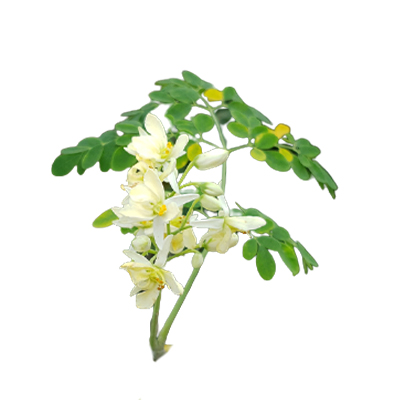Drum stick
Moringa oleifera Lam.
Moringaceae
Location in our garden
Principal



Synonym
Guilandina moringa L.
Anoma moringa (L.) Lour.
Hyperanthera decandra Willd.
Habitus
Trees. An evergreen, slim and medium sized, much-branched tree to 10 m.
Part Used
Leaves
Seeds
Bark
Flowers
Roots
Growing Requirements
Full Sunshine
Drought Resistant
Habitat
Riverbanks
Forest
Coastal
Grassland
Overview
Drum stick originated from India, southern edge of W. Himalaya and is now widely distribute throughout the tropics in South and Central America, Africa, Asia and the Pacific islands. It is cultivated in several other countries of world, yet mainly it is cultivated in India & Pakistan. It is popular, mostly because of its gentle and sensitive pods. It’s got numerous extraordinary benefits.
Vernacular Names
Rawag (Arabic), Cedra (Brazilian), Paizlava (Cameroun), La mu (Chinese), Benboom (Dutch), Ben ailée (French), Behenbaum (German), Kelor (Indonesia)
Agroecology
It is cultivated throughout the semi-arid tropics, tropics and sub-tropics from 250 to 1,600 m elevation. It grows best in areas where annual daytime temperatures are within the range 20-35 °C, but can tolerate 7-48 °C, annual rainfall in the range 700-2,200 mm, but tolerates 400-2,600 mm. Prefers a pH in the range 5.5-7, tolerating 5 - 8.5. It thrives in well drained, sandy-loamy soils with a high water table.
Morphology
- Barks - smooth, light colored or greyish-green.
- Leaves - petiolate, 3-pinnate, 25-60 cm, with stalked glands often exuding clear or amber liquid at base of petiole and leaflets.Leaflets in 4-6 pairs, ovate, elliptic, oblong, 1-2 x 0.5-1.2 cm.
- Flowers -sweet-scented flowers, cream white, arranged in panicles, yellow dots at the base.
- Fruits - long, pointed and triangular, Green when young turning fibrous and grey. Taste more like asparagus.
- Seeds- sub globule, 3-angled, 8-15 mm in diam. excluding wings; wings 0.5-1 cm wide, rarely absent.
Cultivation
- Seed - can be sown either directly, in containers or in a nursery seedbed, preferably with around 50% shade. No seed pretreatment is required and seeds sprout readily in 1 - 2 weeks. Plants can be ready for planting out within 3 months of germination.
- Cuttings of half-ripe wood. Stem cuttings are usually preferred because they root easily.
Chemical Constituents
Oleic acid, ascorbic acid, pantothenic acid, pyridoxine, folate, and phosphorus.
Traditional Medicinal Uses
- Improves nervous and immune system, fights cold and flu, lactation, avoids infection, digestive disorders, lung problems, excellent iron tonic, glowing skin, impotency, tonic for children, urinary disorders, increases bone density, reduces cancer level, reduces intestine tumor or ulcer, improves vision of eye and retina, reduces ladies period cramps, uterus fibroid, asthma, bronchitis, tuberculosis, beneficial for brain injury, reduces diabetic level, makes gall bladder healthy.
- Reduces swelling, as an antioxidant, to prevent spasms, as an aphrodisiac, prevent pregnancy.
- Roots are ground into paste and applied over glandular swellings, used as gargle for painful gums and throat problems.
- Bark powder is used in treatment of epilepsy.
- Extracts from leaves, bark, seed pods, and pulp are used in a variety of folk medicine treatments, either given by mouth or as a topical agent applied to the skin.
- Leaves are considered to be a panacea for malnutrition because of their rich nutrient content, used as vegetable helps to relieve headache, applied externally to relieve pain and inflammation.
- Gum are used for dental caries, and is astringent and rubefacient; gum, mixed with sesame oil, is used to relieve headaches,fevers, intestinal complaints, dysentery, asthma and sometimes used as an abortifacient, and to treat syphilis and rheumatism
- Flowers are useful in intestinal worms.
- Its seed powder, treatment cures headache, potentially for antitumor and anticancer, and microbial elimination.
Part Used
Reference Sources
- Aja, P.M., Nwachukwu, N., Ibiam, U.A., Igwenyi, I.I., Offor, C.E., Orji, U.O. (2014). Chemical Constituents of Moringa oleifera Leaves and Seeds from Abakaliki, Nigeria. American Journal of Phytomedicine and Clinical Therapeutics, 2(3): 310-321.
- Anwar, F., Latif, S., Ashraf, M., Gilani, A.H. (2007). Moringa oleifera: A food plant with multiple medicinal uses.
- Bharali, R., Tabassum, J., Azad, M.R.H. (2003). Chemomodulatoryeffect of Moringa oleifera, Lam, on hepatic carcinogen metabolizing enzymes, anti-oxidant parameters and skin papillomagenesis in mice. Asia Pacific J Cancer Prev 4: 131–139.




